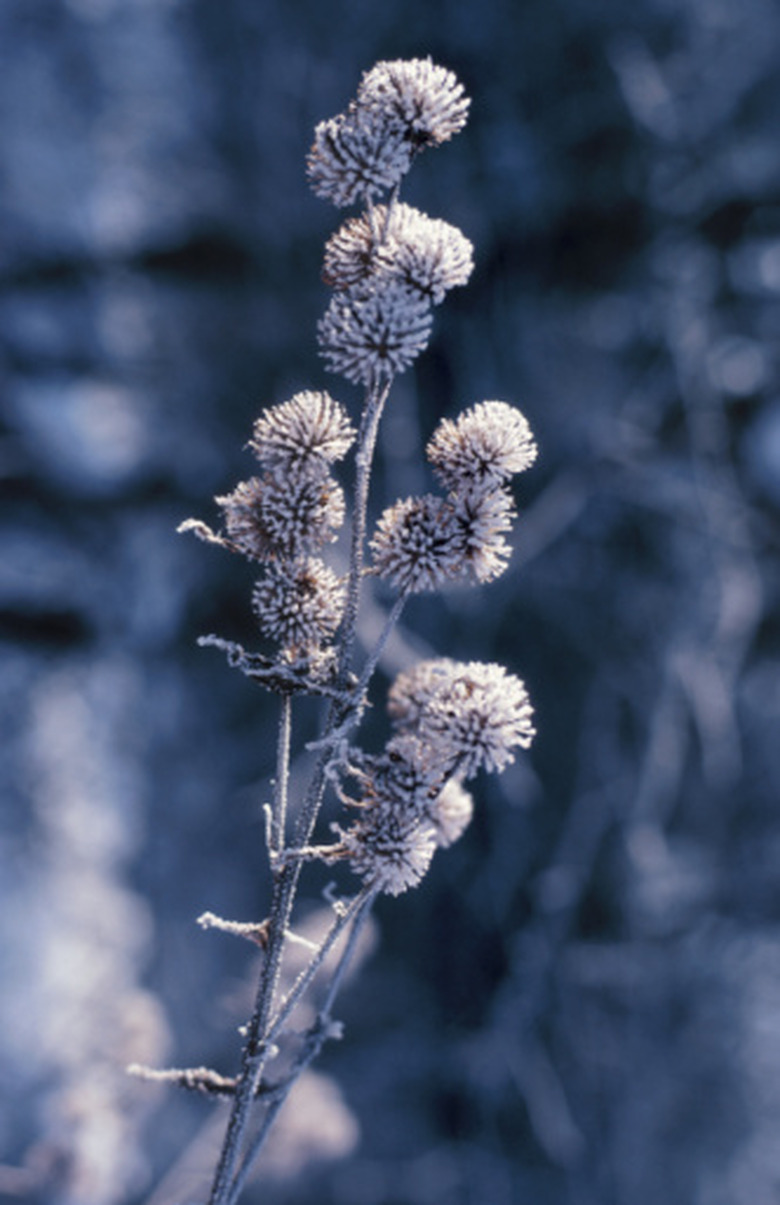Plants With Burrs
Flowering plants have evolved numerous ways of ensuring that their seeds find competition-free soil and water. Some drop their seeds into water for dispersal; others scatter tiny seeds on the wind. Hooked seeds, or burrs, hitchhike to new locations in fur or on clothing. Burrs are such successful adaptations for survival that many plant species with burrs have now become invasive.
Sandburs
Annual sandbur plants (Cenchrus spp.) thrive in warm, sandy soils across much of the United States. These grow up to 20 inches in height and feature leaf blades with downy surfaces and smooth undersides. Their round, 2 1/2-inch burrs occur in vertical clusters, and have skin-piercing hooks. From early summer to mid-fall, the 1- to 3-foot high coastal, or field, sandbur (C. spinifex) produces purple burrs with up to 40 hooks each. Upright southern sandbur (C. echinatus) has erect, 2- to 6-inch leaves. Its October burrs have 40 to 60 spines. Longspine, or mat, sandbur (C. longispinus) may be upright, or spread to form a dense mound. Its burrs appear from July to September, with as many as 50 hooks measuring 1/5 inch or longer.
- Flowering plants have evolved numerous ways of ensuring that their seeds find competition-free soil and water.
- Their round, 2 1/2-inch burrs occur in vertical clusters, and have skin-piercing hooks.
Bur-Reeds
Bur-reeds' (Sparganium spp.) straplike green leaves grow partially submerged in shallow, fresh water. These plants thrive in temperate to cool climates. Giant, or broadfruit, bur-reed (S. eurycarpum) stands from 1 1/2 to 9 feet high. Its slender branching stems bear as many as six spiny, spherical green flower heads. The mid- to late summer flowers yield to hard brown burrs. Narrow-leaved bur-reeds' (S. angustifolia) up-to-3-foot stems each bear from two to four spiny, round flowers and short-stalked burrs. Bur-reeds provide shelter for numerous waterfall species.
- Bur-reeds' (Sparganium spp.)
- Giant, or broadfruit, bur-reed (S. eurycarpum) stands from 1 1/2 to 9 feet high.
Edible Burr Plants
Many burr-bearing plants have seen historical use as food. Common burdock (Arctium minus), a non-native plant to the U.S., now grows in every state but Florida, Alaska and Hawaii. It produces a first-year clump of heart-shaped green leaves. Opening atop spiny green bracts, burdock's second-summer, reddish-purple flowers give way to large, conical burrs. Burdock's spring leaves can be used in salad or as boiled greens; its summer roots are also edible after boiling and peeling. Eastern Native American tribes and early colonists ate Allegheny chinkapin's (Castanea pumila) sweet, spiny-husked chestnuts. This Beech-family tree grows to 30 feet high in sandy, open woodlands from Massachusetts to Florida and west to Texas. It pairs cascading clusters of fragrant, yellow spring blooms with glossy green leaves. Fall foliage varies from yellow to purple.
- Many burr-bearing plants have seen historical use as food.
- Opening atop spiny green bracts, burdock's second-summer, reddish-purple flowers give way to large, conical burrs.
Toxic Burr Plants
Spiny cocklebur (Xanthium spinosum) grows as high as 5 feet on disturbed soils and croplands across the South. Its 1- to 3-inch, white-veined green leaves have spiny bases. A single plant may have as many as 150 burrs, which can survive in the soil for several years. Its seedlings and seeds are toxic to grazing animals, especially pigs and horses. Bur buttercup (Ceratocephala testiculata) invades lawns, roadsides, cropland and pastures. The ground-hugging annual's tiny, yellow blooms appear within a month after its antlerlike spring leaves emerge. They produce tiny, oval burrs before the plants die back in summer. Growing plants contain skin-irritating sap. They're also toxic to foraging animals. Symptoms of ingestion include respiratory difficulty, weak muscles and diarrhea. Sheep have high susceptibility.
- Spiny cocklebur (Xanthium spinosum) grows as high as 5 feet on disturbed soils and croplands across the South.
- A single plant may have as many as 150 burrs, which can survive in the soil for several years.
